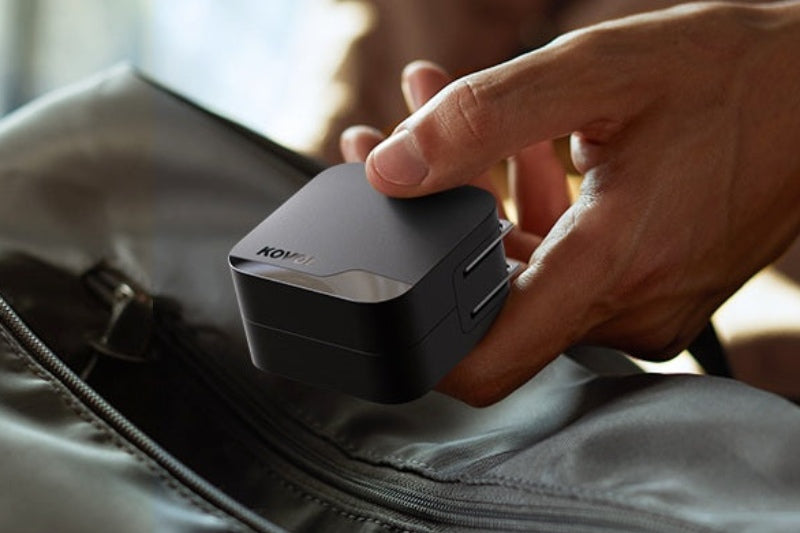People who frequently travel or go on business trips must consider how to keep their mobile phones charged. Most people prefer to carry a foldable USB-C charger, while many others prefer to carry a power bank.
Both devices can keep your phone's battery charged, preventing your trip from being ruined by a dead phone. However, these two devices have distinct advantages and disadvantages; what are their key differences? Which one is essential for travellers? In this post, we'll go over everything and conclude.
What is a Power Bank?
A power bank is a large-capacity portable power supply that is easy to use and carry. It is a portable device for power storage, voltage boosting, and charging management.
The power bank's charging port can directly charge the mobile device via its power storage device, equivalent to a mixture of a charger and a backup battery. Compared to the power station, it is much easier to carry around.
Compared to the USB charger, it has a power storage device that can provide backup power for electronic devices during outages or travelling.
What is a Foldable USB-C Charger?
The USB-C connector is an industry standard for transmitting data and power over a single cable. A standard USB-C connector can deliver 2.5 watts of power, equal to most USB-A connectors.
However, many devices use a charging protocol known as Power Delivery (PD), which allows a USB-C cable to deliver up to 100 watts of power for fast charging.
Common charger prongs cannot be folded, making them difficult to carry on the go; therefore, some charger manufacturers have created USB chargers with foldable prongs to improve portability. A foldable USB-C charger has at least one USB-C charging port and prongs that can be folded.
What is the Difference Between Power Bank and Foldable USB-C Charger?
Power storage is what power banks are built for: on-the-go charging. Power banks have different capacities of power storage units that USB-C chargers do not, allowing you to keep your devices alive when carrying them around, sockets are unavailable, or an outage. The capacity of a power bank is measured in milliampere-hours (mAh); the higher the mAh, the more devices and times a power bank can charge.
Charging speed: When charging low-power devices such as phones, smartwatches, and wireless earphones, the charging speed of a power bank is equivalent to that of a USB-C charger.
When it comes to charging high-power devices like laptops, USB-C chargers are more stable and faster than power banks. However, this does not rule out the possibility of a portable power supply for on-the-go laptop charging. A portable power station can provide enough power to keep laptops running normally for those who have to use a laptop outside frequently.
Compatibility: Power banks and USB-C chargers work well with smartphones, tablets, earphones, digital cameras, and other devices that connect via a USB-C cable. However, as previously stated, power banks cannot charge some high-end laptops due to limited power. Since socket models vary from country to country, when buying a USB-C charger, please choose the correct prongs or buy an adapter to ensure it can work on your trip.
Portability: Power banks and USB-C chargers are portable for travellers, each with advantages. Power banks charge your phone without plugging it into a power outlet, but they are heavier to carry than a USB-C charger and take up more space in your luggage.
Furthermore, power banks containing lithium-ion batteries are not accepted in checked or carry-on baggage when flying. Regular USB-C chargers don't have batteries inside them. So they are much lightweight, and they are fine in both your checked baggage and your carry-on baggage.
Which is Better for Travel?
A high-capacity power bank is enough for short trips to nearby cities for 1-2 days of travel. However, for long-distance travel, bring a foldable USB-C charger and a power bank to keep your devices charged, whether in a hotel or on the go. Thus, even if your phone's battery and power bank are depleted after a day of fun, you still have a USB-C charger to recharge them.
Recommend a Suitable USB C Charger for Travel
Other than mobile phones, you may carry additional electronic devices while travelling, such as a laptop, tablet, switch, and so on. At this time, you require a high-performance charger capable of charging mobile phones, tablets, and high-power laptops. The Sprint 140W PD 2-Port GaN Wall Charger from kovol is one such charger that performs extremely well.

It has a mighty 140W output to charge a MacBook Pro16" up to 56% in 30 minutes. With revolutionary PD 3.1 technology, it can bring fantastic charging performance to your high-end laptop or other USB-C-enabled devices.
Maximum 120W USB-C port and 18W USB-A port for simultaneous high-speed charging of your MacBook Pro and phone. You don't have to worry about your device running low on power.
Kovol's exclusive Q-Pulse technology provides surge protection and prevents overheating for a 100% safe charging experience. This compact GaN-based charger provides higher efficiency while maintaining low surface temperature. PD 3.1/PPS/QC 3.0 charging technology makes it perfectly compatible with almost all mobile devices. These devices include cell phones, tablets, and USB-C laptops. This powerful charger is available in Kovol's stores at a favourable price.
